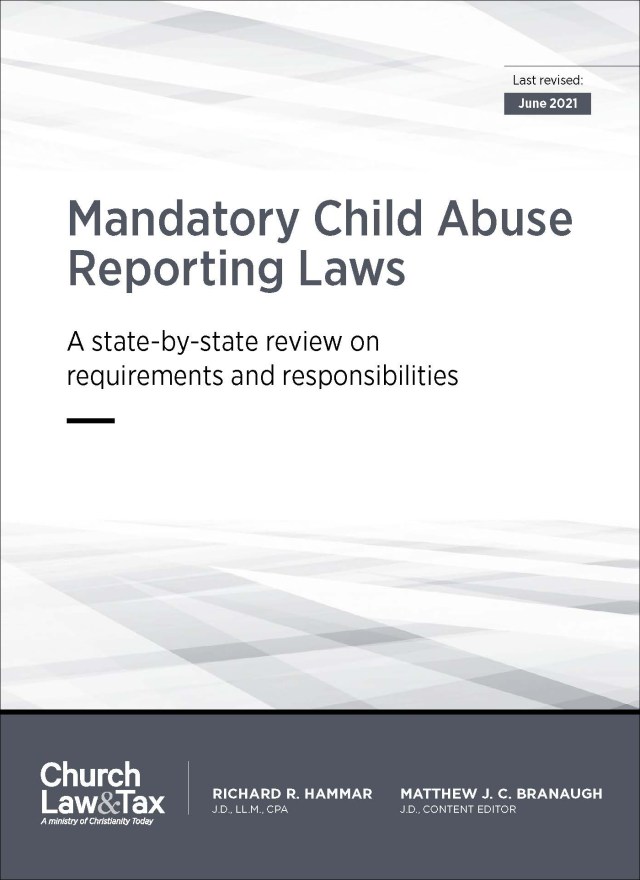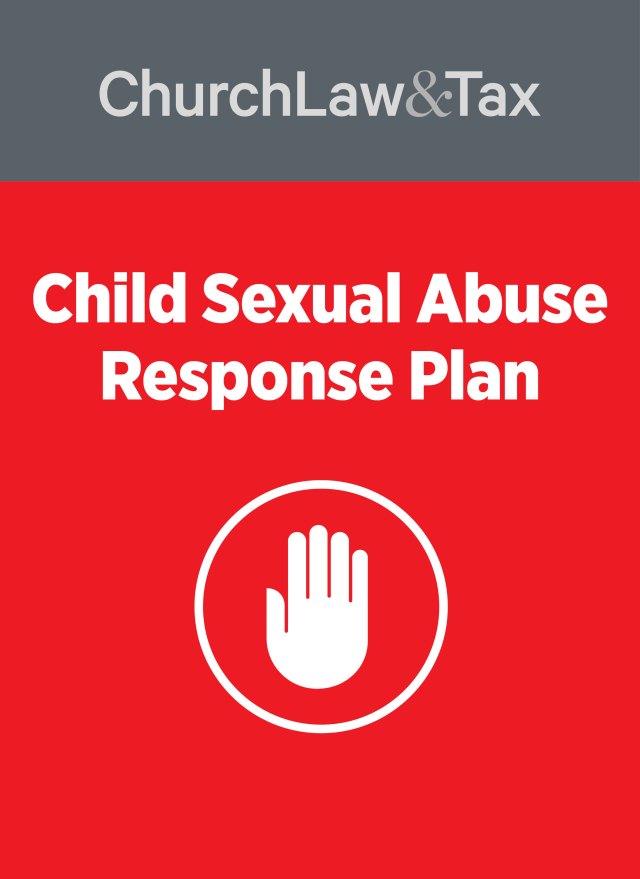These days, churches would do well to pay particular attention to sexual abuse liability coverage as child abuse cases involving churches and ministries are on the rise, especially as states look for ways to extend the time victims have to seek justice.
An essential step in the process is verifying insurance coverage and keeping up with changing laws and regulations.
Why your church needs an insurance check-up
Church insurance has become extremely complicated in recent years due to one reason: child abuse. Tragically, allegations of child sexual abuse remain the number one reason that ministries end up in court. Because of this, sexual abuse liability coverage provides a critical foundation to almost all ministry insurance programs.
Lead Your Church With Confidence—Join Church Law & Tax Today
The statutes of limitation (SOL) that allows victims to pursue abuse cases also has been extended in many states—some temporarily, others for longer. Churches need to understand that they may be defending themselves against an allegation made decades from now.
For example, in New York, the statute of limitations (SOL) for filing a civil suit as a survivor has been extended. Previously, survivors could file up to the age of 23; now, they can do so until they reach 55 years old.
In California, the SOL has been increased from 24 years old to 40 years old, or within five years of the survivor discovering that the “psychological injury or illness occurring after the age of majority was caused by the sexual assault.”
The US Congress recently passed the Eliminating Limits to Justice for Child Sex Abuse Victims Act, eliminating statutes of limitation for filing civil lawsuits for numerous federal sex offenses.
While federal civil claims cases occur less frequently than ones filed in state courts, it’s possible this trend of eliminating statutes of limitation altogether may continue at the state level.
The bottom line: Ministries must ensure that their liability limits and coverage terms are adequate to address potential claims alleging abuses from decades ago—as well as ones arising decades from now.
By following the steps outlined here, your board can identify and rectify significant financial vulnerabilities facing your organization.
Caution. This article focuses on insurance coverage and financial vulnerabilities that churches and ministries face based upon abuse allegations. Leaders must also focus on training, screening, selection, and supervision policies and practices to prevent abuse, as well as ministering well when abuse victims come forward.
Verify sexual abuse liability coverage
The first step to an insurance check-up is to confirm which, if any, of the ministry’s insurance policies contains sexual abuse liability coverage.
Under the list of coverages, you may find this insurance under the names “Sexual Misconduct Liability,” “Sexual Acts Liability,” “Sexual Abuse Liability,” or something similar. If the coverage is included, it is often listed beside directors and officers insurance.
When considering your coverage, it’s important to take note of the liability limit.
You must assess whether your liability limit provides adequate protection given both your involvement in youth activities and the assets you need to safeguard. Keep in mind that these types of allegations can take years or decades to come forward, meaning your ministry may be defending itself far into the future. Due to rising inflation, it’s crucial to recognize that a $300,000, $500,000, or even $1,000,000 liability limit may not hold the same value at the time of a future claim.
Also review your umbrella or excess policy and determine whether it goes over the sexual abuse liability limit. Review this policy’s combined coverage limits. It’s a good idea to review both items with your agent or broker.
How much does sexual abuse liability coverage cost?
Stand-alone abuse liability coverage typically isn’t available, but the coverage can be bundled with your other insurance coverages as part of a package policy. Pricing varies widely, from a few hundred dollars per year for a small ministry with a low limit, to thousands of dollars per year for a larger, more complex ministry with protection extending into the umbrella limits.
Sexual misconduct liability coverage written on an occurrence basis tends to be slightly more expensive due to its permanent protection. On the other hand, claims-made coverage costs less initially but may incur price increases over time as additional years of protection are added.
While price is important, church leadership must be careful when choosing between short-term cost savings and adequate long-term protection.
Claims-made vs occurrence-based coverage
It can take years, even decades, for a sexual abuse allegation to surface.
For this reason, it’s important to verify whether a policy purchased today will provide coverage 20 years from now. The key is knowing the difference between claims-made coverage and occurrence-based coverage.
Occurrence-based: Occurrence-based coverage is essentially ‘lifetime’ coverage. If a covered claim occurred during the policy period, the policy would respond regardless of when the claim was reported.
Claims-made: Claims-made coverage provides ‘temporary’ protection for covered claims during the policy period. To report a claim on this type of policy, the incident must have occurred during the policy period and the claim must have been reported to the carrier within the same period. This period can be adjusted based on a retroactive date (for occurrences before the policy period) or an extended reporting period (granting more time for reporting a claim after the policy expiration date).
It can be tempting for a ministry to purchase claims-made sexual abuse liability coverage for the cost savings. Sexual misconduct liability coverage written on an occurrence basis is typically a bit more expensive because it offers more permanent protection. On the other hand, claims-made coverage costs less initially, but the price may go up you add more years of protection.
However, purchasing claims-made coverage can be a costly mistake. Sexual abuse claims tend to come forward several years after the insurance policy expires. This isn’t a problem for occurrence-based policies; however, the later timing for a reported sexual abuse claim can void coverage under claims-made policies.
For the most adequate coverage, and to pass on a legacy of financial stewardship to the next generation, occurrence-based coverage is typically the better choice for this type of liability.
Legacy liability
At this point, your ministry should have a solid grasp on your current sexual abuse coverage and know where you stand regarding potential future claims. It’s now time to review legacy liability.
By legacy liability, we refer to the risk that your ministry could face a sexual abuse claim today, even though it occurred 5, 10, even 25 years ago.
Document, document, document
Unbroken coverage and good coverage records are crucial in keeping your church well-prepared to address a claim. Your ministry must maintain a file of every insurance policy from today back to its inception, a process sometimes referred to as “insurance archaeology.”
If a claim were to occur, the very first question would be, Who was our insurer back then? This will then raise a few questions:
1. Did we have the right coverage? Review each of your prior insurance policies to ensure that your church, in fact, carried some type of sexual abuse liability coverage.
2. Can we still report a claim? Confirm if your church’s prior policies were written on a claims-made or occurrence basis. If it was claims-made, review the policy to confirm if any coverage still applies.
3. Did we have additional liability coverage? Determine if your church carried any prior umbrella or excess coverage, and whether the sexual abuse liability coverage was an underlying insurance.
Finally, repeat this documentation process for any entities your ministry has acquired or merged with. Merging with or acquiring other organizations carries the risk that unknown liabilities will carry over to the parent entity. If someone sues you over the actions of an acquired organization, your church will want to make sure the absorbed ministry’s insurance will respond.
Retroactive coverage
After performing this exercise, your church may come to the unfortunate conclusion that your legacy insurance policies do not provide adequate coverage. If so, what options remain to avoid a catastrophic financial exposure?
Retroactive coverage provides protection for claims arising from incidents that occurred before the policy’s effective date, ensuring coverage against potential claims that occurred years, or even decades, prior. With retroactive coverage, churches can ensure that they have comprehensive protection for potential claims that may arise from past incidents, even all the way back to the ministry’s inception date.
As more and more sexual abuse claims come forward, this type of coverage is becoming increasingly hard to find. Often, insurance companies will not provide this coverage unless the church signs a statement denying any awareness of potentially pending claims. However, it is still possible to acquire this important coverage. Contact your church’s insurance agent or broker to find out whether your church can.
Your Church Insurance Check-Up Checklist
Regularly reviewing and updating your church’s insurance policies is essential. By following this checklist, you can leave a lasting risk management legacy for your congregation and ministry for years to come.
1. Verify current sexual abuse liability coverage
- Confirm if your existing policies include sexual abuse liability coverage.
- Check the terminology: It may be listed as “Sexual Misconduct Liability,” “Sexual Acts Liability,” or similar.
2. Assess liability limits
- Evaluate whether your liability limit is adequate, considering your ministry’s involvement in youth activities and the assets you need to protect.
- Account for future inflation and the potential for allegations to surface years later.
3. Review additional coverage
- Examine your umbrella or excess policy to see if it extends over your sexual abuse liability limit.
- Consult with your insurance agent or broker to confirm your combined coverage limits.
4. Evaluate coverage type
- Given the long-term nature of sexual abuse allegations, strongly consider occurrence-based coverage over claims-made coverage.
5. Document previous policies
- Perform “insurance archaeology” to compile all previous insurance policies, including those of acquired organizations.
- Review each policy for its type of sexual abuse coverage, if any.
6. Legal consultation
- Consult your attorney or a specialized church insurance agent regarding your jurisdiction’s statutes of limitations in the context of your insurance history.
7. Assess legacy liability
- Document any acquired or merged entities, and review their insurance policies for evidence of prior sexual abuse liability coverage.
8. Explore retroactive coverage options
- Review your legacy policies with the board and church leadership, and if needed investigate purchasing retroactive coverage.
9. Maintain comprehensive documentation
- Keep all insurance policy records, both current and past, in a well-organized and accessible manner.
By taking these steps, you can ensure that your ministry is adequately protected against potential risks and liabilities, both now and in the future.
Charlie Cutler is managing partner, ChurchWest Insurance Services.



